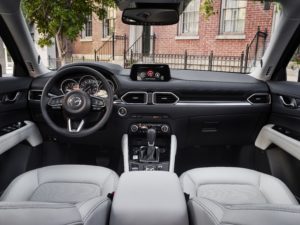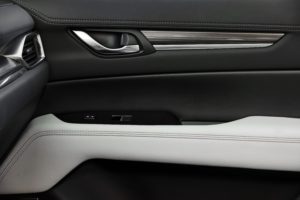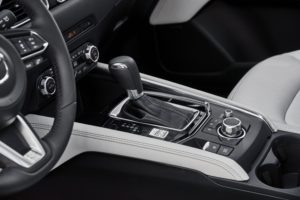There’s a tier of automakers who keep their lineups spare, betting only on the vehicles and technologies that will keep them competitive. Mazda falls squarely into this category, and its bets have been paying off handsomely. The Japanese automaker made a stir in 2017 when it debuted a vehicle that runs on a homogeneous charge compression ignition (HCCI) engine. Pundits have been discussing this cleaner-burning, fuel-economy-enhancing technology since at least 2014. In 2017, Mazda put a prototype on German roads for automotive journalists (excluding, sadly, yours truly) to take for a spin.
Meanwhile, Mazda hasn’t been standing still, waiting to bring this groundbreaking technology to market. Ongoing refinement of its SKYACTIV technologies and KODO Soul of Motion design are evident in all its models, including the latest all-new CX-5 AWD.

First impressions
I’m sure there’s a reason Mazda loves to loan reviewers vehicles in its Soul Red Metallic finish, now altered slightly and known as Soul Red Crystal Metallic. It isn’t quite like any other red you’ll see on the road, and this subtle difference works in Mazda’s favour. Judge for yourself – check out the picture of the 2016.5 CX-5.
That red helps set off the redesign for the CX-5. It stays true to Mazda’s Kodo Soul of Motion design direction while adding sharper edges in places like the hood where it juts out over the front grill and the taillights as they stick out of the sides of the hatchback. Squintier headlights add to the more aggressive look without going too far into territory staked out by Japanese rivals.
Interior
Firm, power-adjustable front seats ensure a comfortable ride. As you might expect, headroom is not a problem even for tall people, front seat or back.

image courtesy Mazda
Piano black, gunmetal and wood accents touch up an interior that seems ruled largely by minimalist design.

image courtesy Mazda
Leather on the shift knob and heated steering wheel add an upscale feel.
There’s a separate button for the heated steering wheel, but at least Mazda placed it beside the button for the driver’s seat heater so you don’t need to hunt for it.
That last paragraph was my best attempt to nit-pick in the CX-5 cabin. I’m no fan of the moonroof either, but it’s part of the Comfort Package featured on my tester.
Comfort is the word, as well as convenience. Two USB connections reside under the centre armrest AND in the rear-seat armrest, for a total of four ports. That’s three more than in other vehicles in this class I’ve driven lately.

image courtesy Mazda
Hockey bag test
Two hockey bags and sticks fit easily into the hatch. Sticks reside in the centre seat passthrough. Fold the rear seats down entirely and the CX-5’s cargo capacity becomes cavernous enough to fit four bags flat (I speak from experience.) or eight if you don’t mind cutting off the generous view out the rear window. (I refused to try this.)
In-cabin technology
Mazda sticks with its tried-and-true 7” in-dash screen run by Mazda Connect and controlled largely by the HMI Commander dial/button/joystick. The Commander sits behind the gearshift, surrounded by five buttons for commonly accessed features.

image courtesy Mazda
Unlike the 2016.5 model I drove earlier in 2017, Mazda returned to the tablet-stuck-into-the-dash look instead of embedding the screen into the dash. The frame is substantially wider than the visible part of the screen, which makes the screen look less like a design afterthought.
New in this model: Mazda has done away with the flip-up screen that enables its colour Active Driving Display (heads-up display). Mazda’s HUD has joined the crowd and now projects its contents onto the front windscreen. The images appear several inches above the front edge of the hood. This display shows, among other things, upcoming traffic signs and the following distance for Mazda’s radar cruise control, both new features on the CX-5.
The instrument cluster doesn’t feature vehicle settings. You’ll find most of these using the main screen at the top of the dash. Audio from Sirius, FM or AM radio, or my phone, were pumped through an available set of ten Bose speakers.
Surprisingly, Mazda has yet to integrate CarPlay, at least in this CX-5. The upside is that Mazda’s screen-based user experience is well above average among automakers. It’s about as easy to figure out as the systems on your smartphone and just as attractively designed.
As mentioned previously, two USB ports up front and two in back mean all passengers can recharge their devices while on the go. The audio system will recognize both devices connected via the front-seat USB ports, as well as Bluetooth.
Driving
My tester featured a 2.5L I4 SKYACTIV engine that sent power to all four wheels through a 6-speed automatic transmission. This SUV is no sprinter, but 187 hp and 185 lb-ft of torque sufficed to get the CX-5 moving quickly enough.
Flip the Sport switch, right by the gearshift, and the CX-5 will shift at higher RPMs and act more like a performance vehicle. I found the ride civilized and quiet, though it got a little buzzy when I accelerated with some urgency.
My CX-5 tester features Mazda’s radar cruise control. I increasingly consider this to be the upgrade that makes cruise control useful in stop-and-go driving. If you come to a stop on the highway and traffic starts moving again, just tap the accelerator and the system takes over again. You’ll need to upgrade to the iACTIVESENSE Package to get this and goodies like smart brake support, lane-keep assist and the forward obstruction warning systems. All these “senses” use the same sensors, hence the packaging of these and other “senses” plus the high beam control system.
I don’t understand why Mazda (or other carmakers – they’re all guilty of this) would offer following distances of less than two seconds. Two seconds is the maximum distance offered. It enabled the CX-5 to react quickly enough to other vehicles cutting in front, whereas running any more closely during a cut-in would have meant a sharp tap on the brakes. This isn’t a huge deal, given how easy it is to reengage radar cruise control. Still, I’m not a fan of shorter following distances, because safety.
A neat feature in Mazda’s radar cruise control: using the active driving display (heads-up display) it shows both the following distance set by the driver and the “actual” distance of the vehicle ahead. The CX-5 adjusts its speed until the actual distance matches the set distance.
Mazda doesn’t scrimp on other active safety features. Dynamic stability control, traction control and rear cross traffic alert ought to hep CX-5 drivers stay out of difficulty.
Fuel economy
The Mazda’s in-vehicle fuel economy numbers added up to 8.6 L/100 km during my week with this crossover. It takes regular gas in its 58L tank.
Pricing
The base Mazda CX-5 GX, FWD with a 6-speed manual transmission driven by a 2.0L I4 motor, sells at an MSRP of $24,900. (Prices mentioned here exclude extra charges like freight, PDE and an air conditioning surcharge.)
All other models retain the 6 gears, but they’ll shift automatically. Most other models in the lineup also feature the 2.5L I4.
The GS starts at $29,100 and the GT starts at $34,700. My tester, outfitted with all three packages – i-ACTIVESENSE, Comfort and Technology – tops the lineup at $36,300 MSRP.